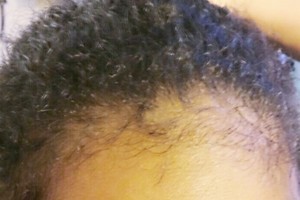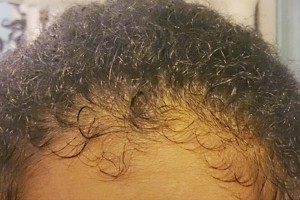There are a number of particularities concerning the fall of frizzy or mixed-race hair require a great deal of attention, and warrant their own special section. The appropriate treatments should also be the subject of a special report. Hair loss can be caused by the usual general factors: a hormonal problem, thyroid deficiency, stress, dietary deficiencies, etc. But it is much more often linked to specific Afro hairstyling practices: braiding, adding on, weaving, straightening.
Don't confuse hair loss with hair breakage
Do not confuse hair loss in the traditional sense of the word, and hair breakage. The two problems do not have the same origin. The first is caused by a disruption in the hair cycle, with the hair falling out with the roots. The second involves hair that has been weakened by a lack of moisture breaking in two.
Hair loss: external factors linked to hairstyles
Hair loss due to traction

Unlike Caucasian or Asian hair, the traction hair loss is (along with breakage loss) the most common cause of frizzy hair loss, well ahead of hormonal hair loss.
Causes
They are triggered by the continuous traction that small braids and overly heavy hair additions exert on the bulb. This traction pulls the roots away from their irrigation zone and precipitates hair loss. Too often called upon to produce new growth, hair follicles slowly atrophy and eventually stop producing hair altogether if they are not treated in time.
The most common symptoms
Baldness often begins with a receding hairline on the front of the head. Hair is also thinning on the vertex (top of the head). The condition is sometimes accompanied by signs of inflammation of the hair follicles (folliculitis), with the formation of tiny pustules around the hair or new growth.
Advice
When the symptoms of a hair fall due to traction are identified during diagnosis, our first recommendation is to encourage you to lighten the weight of your additions (if you wear them) and create looser plaits over the first few centimetres, starting from the roots. This will allow your hair to breathe and not suffer from atmospheric variations. When the air is dry, hair is less elastic. It retracts and the roots are pulled outwards (which weakens the hair).
Treatments
It takes a little patience and diligence, but the Clauderer results are spectacular after four months of treatment.


The method requires three successive operations for each treatment:
- Massages designed to remove tension
- Application of an anti-inflammatory and healing Lait Clauderer to cleanse the scalp.
- Application of a Clauderer Serum to reactivate the remaining hair follicles. These serums, tested by Professor Herbein's team at the Besançon University Hospital, have demonstrated their ability to regenerate hair stem cells and their effectiveness in regrowing hair.
Hair loss due to straightening
They are linked first and foremost to the natural vulnerability of frizzy hair, which is genetically half as strong as Asian hair and a third weaker than Caucasian hair. However, these breakages are considerably amplified by the straightening process and can lead to hair shafts breaking at any length, including close to the scalp. What's more, this fragility is greatest where the hair has been the most damaged by plaiting and additions. The forehead, for example, often has a characteristic depilated appearance, sometimes accompanied by dermatitis as a reaction to straightening.

Diagnosis
During the diagnosis of the roots, keratin and scalp, the Clauderer Specialist draws a distinction between this hair loss caused by breakage and pathological hair loss, such as those described below, even though two types of hair loss can coexist on the same head of hair. It is in fact common for hair loss caused by straightening to be coupled with another type of hair loss (hormonal hair loss, hair loss due to traction, lack of iron, etc.). Breakage loss is characterised by the fact that when you run your hand through your hair, you don't bring back whole hairs with their roots, but pieces of hair, sometimes even whole clumps of broken hair.
Applying a straightening product should start about 5 mm from the roots to avoid damaging your scalp. It should only be applied to curly new growth, and never to relaxed lengths. Finally, you should never straighten your hair immediately after braiding, as it won't stand up to it... A minimum of two weeks, accompanied by intensive care, is needed to allow the roots to reoxygenate.
Treatment
For treatments, see our special report Frizzy/straight hair: care and repair
Frizzy or mixed-race hair loss: internal factors
Hormonal (androgenetic) hair loss
In the case of frizzy hair, it is much less frequent and takes longer to develop than in the case of Caucasian hair. Almost always hereditary, it is due to a dysfunction of the androgen hormones in the scalp, and manifests itself by a thinning of the hair, followed by its gradual disappearance from well-defined areas of the head.
- In women, androgenetic hair loss is located on the top of the head and the vertex and often appears during childbirth or, much later, at the menopause.
- In men, it results in baldness gradually on the gulfs, top of the head and vertex (tonsure).

Stress-related hair loss
Stress and also fatigue or a violent emotional shock can cause hair loss to spread over the whole head or just the sides (this is the case for women). Moving house, a change of climate and lifestyle can also cause this type of hair loss.
Hair loss due to iron deficiency
These are diffuse falls of hair all over the head. They mainly affect women and begin with a characteristic thinning of the keratin and hair roots. More common in Afro-Caribbean women than in Western women, they should be systematically screened if you wear an IUD, have heavy periods or have had multiple pregnancies.
Hair loss and vitamin D deficiency
Afro-Caribbean and African women are more likely than Western women to lack vitamin D. This can be an additional factor in hair loss.
Diagnosis
The first thing to do is to establish a hair diagnosis with root and keratin analysis. This analysis of your roots and keratin is essential, as it will dictate the choice of your treatment. This analysis enables us to determine the cause(s) of your hair loss and to distinguish between triggering and aggravating factors, so that we can better adjust the treatment protocol we propose.
Treatment
As we pointed out above, to neutralise hair loss and encourage vigorous regrowth, you first need to rebalance your scalp's particular ecosystem. Our anti-hair loss care for frizzy hair has two components: preparing the scalp (with Laits Clauderer) and stimulating blood circulation and root activity (with Serums Clauderer).


Hello
For a few months now, I've been balding at the front and back, and it's continuing. My hair has become very damaged and is breaking. I'd like to know whether I should consult a dermatologist/venereologist for a diagnosis.
Yours sincerely
TOCNY MAGUY
Hello,
We can certainly help you understand the causes of your hair problem. Don't hesitate to contact us for an appointment in Paris. If you can't come to the Centre Clauderer, we can carry out your analysis by mail: all the information is on our website, under the heading "I want a diagnosis". Yours faithfully The Clauderer team